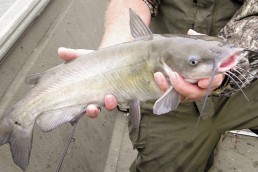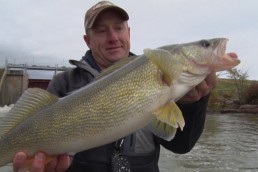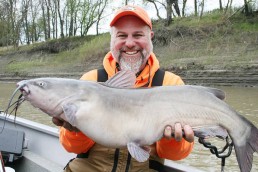For More River Catfish, Try Drifting ‘Crawlers
SHARE THIS POST
June is one of those months when the great fishing we’ve been experiencing on many Midwestern rivers starts to slow down a bit. The waters have warmed and the fish are now changing their feeding habits. While many of the species of fish that live in Midwest rivers have started a change to a predominantly low light feeding regimen to avoid the heat of the June sun, there is one species that continues to feed quite heavily. I’m speaking of the catfish. By getting out in the early morning hours before the heat of the day arrives in full force, and again in the early evening light, the savvy angler can really cash in on some nice, tasty catfish that are more than willing to take a particular presentation when offered to them.
With the river fishing conditions like they are now, fishing one of nature’s best baits will work some magic for you. I am referring to the slithery nightcrawler. Right now, by fishing these natural baits in a certain way, you can enjoy some really fast and furious catfish action that will surely get the heart pumping.
It’s no secret that drifting a nightcrawler is a very basic presentation that can definitely put a lot of nice fish in your basket at certain times. This is especially true with the water conditions that we experience this time of year. Using some lively nightcrawlers in low or average, stained water conditions, I will guarantee you’ll catch some fish. Also, when using this great natural bait, you open yourself up to catching many other different species of fish that enjoy eating ‘crawlers. This is one of the things that make nightcrawler fishing so much fun, as you never know what you will catch. For this particular presentation, we are going to concentrate on those hungry catfish.
After gathering some fresh, lively nightcrawlers and keeping them healthy, it’s now time to go and catch some catfish. If at all possible, don’t use store-bought nightcrawlers unless you absolutely know that they are fresh. Unhealthy bait will ruin your day for sure.
One of the best methods for the water conditions we have now is to simply drift fish a single nightcrawler in a completely natural presentation that the catfish are looking for. This is actually quite simple and requires only some basic tackle.
First of all, you are going to want to use a rod that is in the medium to medium-light range for this particular style of river fishing. Lengths in the 6-foot, 6-inch to 8-foot range are great. The longer rod will give you much better control over what your bait is doing in the water.
As far as line is concerned, I personally favor a lighter, thin diameter line in the 8 to 10-pound-test range. However, in the stained water, you can get away with the 10-pound-test if you feel more comfortable.
For your hook, nothing beats a small, wide bend salmon egg hook in either gold or colored style—the choice is yours. Personally, I have had the best luck using an all gold hook. You’re also going to need a small, balsa wood float that has high visibility so that you can see it well in the water as your nightcrawler presentation seductively drifts along with the river’s current.
Are you enjoying this post?
You can be among the first to get the latest info on where to go, what to use and how to use it!
To start, simply place a few small split shot on your line about one foot up from the hook. Now, simply take one of those fat, lively nightcrawlers you have collected and hook it lightly through its nose end and your ready to fish.
(Note: The head of the nightcrawler is always located on the end of the nightcrawler closest to the clitellum, or dark ring. If you’re not sure, simply place the nightcrawler on a rough piece of paper and observe which direction it travels. Nightcrawlers usually extend their “head” first when crawling.)
Now, before you cast out your offering, make sure you initially have your float set at a depth of about 2 to 3 feet from your hook as a starting point.
To present the ‘crawler to the catfish, gently cast it upstream from the shoreline structure where these catfish are holding and let the natural current drift the ‘crawler past the structure in a nice, natural motion. Remember that the crawler is in the water, squirming as it drifts along, which is usually too good for the fish to pass up. This type of presentation looks extremely natural as it moves along and the big catfish just love it. Make sure that you keep your rod tip fairly high and closely follow the downstream movement of your ‘crawler as it drifts along. Also, remember to keep a fairly tight line so that you can maintain better control of the drift. If the catfish are holding in the area, you’ll know it pretty quickly with this setup.
When you’re heading out to fish, try to concentrate your efforts on fast tapering shorelines that are made up of rocky and gravel structure. These areas are where the catfish are holding, waiting for an easy meal to drift by. Once you get into an area that contains some catfish, you will be amazed at just how many fish can be caught from that spot. Believe me, they can really pack tight into an area and will provide some great catfishing action.
If you find the cats are not in the rocks or gravel, don’t hesitate to try shoreline areas that contain sunken timber. These areas also hold some very nice catfish. Use the same drift presentation and keep a tight grip on your rod.
Email your outdoor questions to Mike Cyze at: lastcast13@yahoo.com. You can also check out Cyze’s blog at: lastcastoutdoors.com or listen to him on ESPN Radio.
MWO
SHARE THIS POST
Did you enjoy this post?
You can be among the first to get the latest info on where to go, what to use and how to use it!
Mike Cyze
Mike Cyze has been called one of the most knowledgeable multispecies river anglers in the country. His ability to catch fish under the challenging conditions encountered in the river environment, combined with his overall fishing knowledge, has earned him recognition as a true Mississippi River Expert. Contact him at: lastcast13@yahoo.com.



